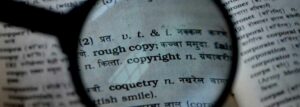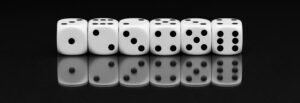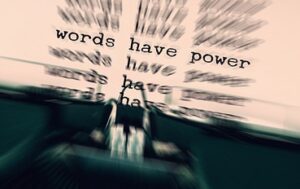10 Nonfiction Book Layout Tips That Will Glue Your Audience to the Page

A good quality book layout is important for books in any genre, but it’s essential for nonfiction books that deliver solutions to an audience.
Most readers will use these books more as reference manuals than as books they read once and then put away on a shelf. There’s usually so much actionable information in them that constant reference needs to be a key design criteria.
As a matter of fact, according to statistics from Amazon Kindle, almost 70% of the most electronically-highlighted books on their platform, excluding the bible, are titles meant to inform and educate users: The 7 Habits of Highly Effective People, the 4-Hour Body, Steve Jobs, and The 4-Hour Workweek.
It’s for this reason that great care must be taken when balancing all the necessary visual aspects that appear on each page of your book.
Book layout is part science and mostly art – specifically spatial art. As a result, this is not something that you want to take care of yourself. This is something that you want to leave to the experts in consultation with you, so that you can guide them with your overall vision while they do the actual work.
There’s a lot riding on the quality of your writing, as well as your book design and book layout. These elements will either reflect positively or negatively on your professionalism, and by extension on your reputation.
My recommendation is for you to create with the help of an editor the best possible manuscript you can, and then hire professional book designers to take care of your book’s look and feel.
Even so, it’s good for you to develop a clear understanding of what makes a nonfiction book “pop” so you can provide valuable feedback to your book designer.
Here are ten book layout tips, one for each of the ten key layout areas that must be nailed in order to produce a book that will be easy on the eyes and appealing to the mind.
Tip 1: Size Does Matter for Book Layouts
The physical size of your book (referred to in the industry as your trim size) is the first decision you’ll need to make in conjunction with your book designer.
Standard trim sizes are the least costly to produce by your printer because most printing machines are preset for those sizes and they generate the least amount of paper waste. Custom sizes always have a higher cost per book because they tend to produce more waste.
The vast majority of nonfiction books come in three popular standard sizes:
5” x 8”
This size is typically used for paperbacks only, although there are exceptions.
5.5” x 8.5”
This size is used for both paperbacks and hardcovers.
6” x 9”
This one is used for both paperbacks and hardcovers.
In general, the size you choose is determined by your total word count. The highest cost driver for printed books is the page count. If you have a large word count and you want to limit the number of pages in order to lower your cost per copy, then a 6” x 9” trim size is advisable. If you choose small trim sizes instead (say 5” x 8”) you may end up with an overly thick book, which will not only cost more to produce but also may be a turn-off for some buyers.
On average, a 5” x 8” book will fit between 250 and 350 words of text per page. A 6” x 9” book, on the other hand, will fit between 350 and 450 words per page (if you add images or graphics, then the word count per page will decrease).
For example, a 70,000-word manuscript will require approximately 200 pages in a 6” x 9” trim size – using the lower end of the range at 350 words per page to account for the inclusion of some images and graphics. The same number of words in a 5” x 8” book would instead require 280 pages.
Tip 2: The Right Font Style Will Glue Readers to the Page (The Wrong Font Style Will Repel Them!)

The font style you choose for your book layout design is the virtual “glue” that holds your reader’s attention.
To the layperson, most fonts of the same type and size look similar (e.g. most serif fonts or most non-serif fonts). But in reality, the design of a font can make a huge difference in reader retention.
Even subtle differences in the quality of a font can make a big difference between a reader gliding through the page and a reader experiencing tiredness when reading a book.
This is another reason why you should hire a professional designer to select the right fonts for your book. There are literally thousands of fonts to choose from, and if you were to take on this task it would quickly become overwhelming.
Finally, you never want to use a font style and font size that are so different that it becomes a distraction from the content of your book, even if you feel it’s appropriate.
Tip 3: Line Spacing is Much More than Just the Space Between Lines
Line spacing is critical for readability. It’s also dependent on your font sizes. To much line spacing and your book layout looks sparse. Too little and your readers will get a headache.
Here, again, you need to rely on the expertise of your professional book designer to find the right balance. Also, their advanced book-design software tools already have built-in algorithms to find the most efficient line spacing for a given choice of font and font sizes.
Tip 4: White Space in a Book Layout Is Not Empty Space

White space in a book layout refers to the absence of any design elements. A well laid out book has the right balance of white space and printed elements.
If you use too little white space (for instance by using very thin margins and little space between paragraphs) your book will feel visually cluttered and it’ll be very uncomfortable to read, even with the most appropriate font size and line spacing.
The key for nonfiction books is to strive for the perfect balance between white spaces and textual or graphic elements, because their readers will often re-read the same page or even a specific paragraph several times.
This is again an area where professional book designers come in very handy because they are true visual artists.
Tip 5: Margins Improve Readability in Your Book Layout
Margins are used to manage the balance between white space and the printed elements in your book layout design. Technically, they’re also needed to make sure that printing shops have enough space to bind the books. But their primarily function is to help “anchor” the reader to the page.
If margins are too wide, the text appears to float in the middle of the page. Margins that are too narrow (which can be tempting to use because it lowers your page count and the cost of each printed copy) will result in cluttered text and make for a very uncomfortable read.
Tip 6: Be Creative with Your Chapter Pages

This is an area where a good designer with strong attention to detail can make the inside of your book really shine. When you look at other nonfiction books, you’ll find that the first page of each chapter looks different than the other pages: They have a “special” look.
This is also an area where you can give your book layout personality by playing with different design elements.
For example, many authors take visual cues from their book covers and use them in the chapter pages to give their books a unique identity. Not all books take advantage of this feature, but some do it to great effect.
Tip 7: Use Headers and Footers as Navigational Tools in Your Book Layout
Aside from holding your page numbers, a well-designed header can be a great navigational tool if you have a large or detailed table of contents.
Using this valuable real estate just for the name of the book and the name of the author is redundant and not necessarily the best use this space. Consider instead using the chapter title and section (or sub-section) title as the header content.
Tip 8: Place Images, Illustrations and Charts Strategically to Help Readers Better Absorb and Digest Your Content

Graphic elements that are used with a lot of thought and planning can truly enhance the delivery of information in your book.
From photographs to images, illustrations, charts, diagrams and tables, the judicious use of these graphical elements can greatly enhance your book’s reading experience and help improve your reader’s understanding of your content.
The key thing is balance. Too many graphics can become distracting to your reader. Too few graphics will make your reader wonder why the graphics are even there.
Also, make sure that every single graphic element has a clear purpose and isn’t just used to provide a break to the text. Your readers are a very discriminating group and they expect all information to be in your book for a reason. Confusing graphics are a sure way to lose them fast.
Tip 9: Make use of Breakouts to Help Readers Retain Information
Breakouts are text-box elements where key takeaways from your book can be pulled out of the main text and given a much larger font and a different background to make them stand out.
They can add much value to your books provided that they are used judiciously. First and foremost, only highlight phrases that contain a key point, discovery, or takeaway from your book, but also make a plan ahead of time for these textual devices throughout the book to ensure that there is a logical flow from text-box to text-box.
Balance is once again key here. Too many boxes will become a distraction and take away from the reader’s enjoyment, and too few will make the reader question why they are there in the first place.
Tip 10: Don’t Make Your Table of Contents Boring and Utilitarian
The final tip is to make sure that your table of contents serves the purpose not just to navigate people throughout the book, but also to provide them with a clear informational roadmap.
Your editor will be of great help in organizing your table of contents to have a clear flow and to be useful beyond navigation.
What you don’t want is a table of contents that is too “thin” (not enough details beyond the chapter title and a couple of headings) or too “dense” (so much information that it becomes overwhelming).
Visually speaking, this is an area where your designer, in consultation with you, can play with different font sizes and text positioning for added emphasis.
You Now Have the Basics For a Strong Book Layout
The main lesson is to always strive for balance:
- Balance between white space and textual elements
- Balance in your line spacing
- Balance between graphical elements and text
- Balance in the use of breakouts
- Balance in the design of your table of contents
The above information will allow you to have an informed conversation with your book designer as you define together the type of layout elements that will best represent the message contained in your book.
Best of luck in your book layout design!
If you enjoyed this article and are in the process of writing, designing or self publishing a book, be sure to check out my free nonfiction success guide, drawn from years of experience editing books for bestselling authors (including a New York Times bestseller) and ghostwriting for CEOs and politicians. Simply click here to get instant access.
Ben
Leave me a comment below if you have any questions or a specific need that I can help you address – I operate an author services firm that specializes in helping entrepreneurs, professionals and business owners looking into self publishing books as a calling card for prospects, to establish their status as an expert or to generate additional leads for their businesses.
Here are some related articles I highly recommend:
How to Write a Compelling Book Introduction That Will Move the Needle
How to Come Up With Killer Book Titles for Your Nonfiction Book
 Bennett R. Coles is an award-winning author of six books published through Harper Collins (New York) and Titan Publishing Group (London). He is also the publisher at Promontory Press, editor for multiple bestselling authors (including a NY Times bestseller), ghostwriter for CEOs and politicians and the founder of Cascadia Author Services, a boutique full-service firm that specializes in premium author services specifically designed for busy professionals. Our end-to-end service includes writer coaching, ghostwriting, editing, proofing, cover design, book layout design, eBook production process, marketing, printing and distribution.
Bennett R. Coles is an award-winning author of six books published through Harper Collins (New York) and Titan Publishing Group (London). He is also the publisher at Promontory Press, editor for multiple bestselling authors (including a NY Times bestseller), ghostwriter for CEOs and politicians and the founder of Cascadia Author Services, a boutique full-service firm that specializes in premium author services specifically designed for busy professionals. Our end-to-end service includes writer coaching, ghostwriting, editing, proofing, cover design, book layout design, eBook production process, marketing, printing and distribution.
7 responses to “10 Nonfiction Book Layout Tips That Will Glue Your Audience to the Page”
-

This is an excellent article every aspiring author should read. With this information, they will make much better decisions about who to hire for the services they need for successful publishing.
-

Thank you!
-
-

Thanks 😊 Ben, really appreciate this article. Happy New Year 🎉🎉🎉
-

Dear Bennett, Thank you so much for this article. It is so informative and very timely. You convinced me of the importance of hiring a book desigh professional. You are so generous with your information and I greatly appreciated it. Thanks a million. Maryse
-

Under tip #1 in the last paragraph of 6″ x 9″ book size, it says “70,000 page manuscript” – it was a bit confusing. Should it have been “70,000 word . . .”?
-

Good catch, Annie! You should be an editor 🙂
-
-

This a very helpful article. Do you something similar for fiction books.







Leave a Reply